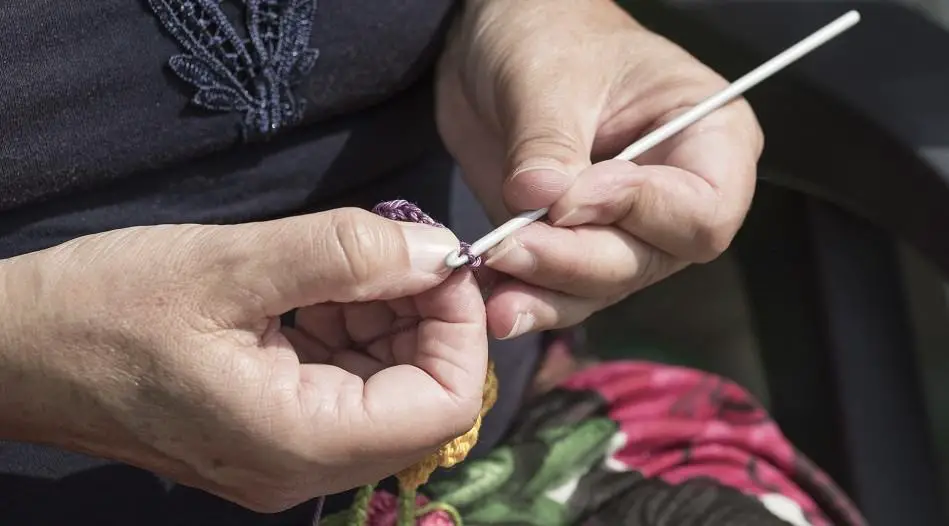Crocheting, like many other hobbies, can result in different kinds of injuries. Some people think that sounds silly, but as with anything, there are risks and benefits!
Crocheting is a rhythmic, repetitive process and can lead to repetitive use injuries such as tennis elbow, golfer’s elbow, carpal tunnel syndrome, and bursitis. All of these cause hand, wrist, elbow, or shoulder (arm) pain. Over a significant period of time, crocheting can lead to arthritis due to “wear and tear”. There are ways to prevent all of these injuries.
Crocheting can be an addictive activity. It is repetitive and relaxing. It can be very complex and engrossing or very mindless. Both of these can lead to you doing it for a prolonged period of time without any rest breaks! This can lead to arm pain, but it is definitely preventable!
Crocheting and Injury: Risk Factors
Repetition
Due the the nature of crochet, REPETITION, it puts you at risk for a repetitive use injury. Gripping a small item (crochet hook) and then manipulating it to create stitches uses very specific muscles, which with prolonged use can become inflamed. Depending on the technique, this inflammation can happen in different areas. This could lead to generalized pain. Some of the conditions it could cause are lateral or medial epicondylitis (tennis or golfer’s elbow), Carpal Tunnel Syndrome, or bursitis. Over a lifetime of crochet, it can also result in arthritis (wear and tear) of the joints in the fingers or wrist.
Combined Movement
Combined movements such as those required in crochet also increase the risk. You are simultaneously gripping the hook and rotating to loop yarn and pull through. This causes increased strain on the areas used.
Crochet Injury Prevent
Take Breaks
Taking breaks is the most important part of prevention for repetitive use injuries. According to Mayo Clinic, to develop a repetitive use injury like golfer’s elbow, the motion has to be performed for more than an hour each day. If you are planning to do more than that a day, you need to incorporate rest breaks.
Taking a 10 minute rest every hour should be sufficient. If you tend to get wrapped up in the task and forget about the time, I recommend setting a timer to remind you to take a break. Many work places have done this on computers of those who do desk work to help prevent repetitive use injuries, and it will work the same for hobbies as well! Just try to avoid those 5 hour marathon crochet sessions!
Also, if you are newer to crochet, or haven’t done it in a while, you may need to ease into it. Plan to spend less time a day and to take more breaks because the muscles are likely not as developed and you could be at increased risk as well. As with any new tasks, you don’t want to go in full force.
Ensure Proper Posture
Good posture is important to reduce the risk of any injury. Everything “up the chain” affects your position and how the muscles are used. Try to sit up tall and prevent the neck flexed/rounded back look that is so common for those who work with their hands.
Also supporting your elbow and forearm will help decreased the amount of strain on the muscles. You can use pillows or an armrest to do that. Try to keep your arms close to your body as well, because increasing the length of the “level” increases the amount of strain.
Stretch
Stretching the muscles of your hands, wrists, forearm, and even your shoulders and back will help prevent or reduce discomfort. Some options for this are as follows:
- Open and close your fingers, thinking very large movements, very slowly
- Rotate your wrists in both directions with a closed fist
- Press your palms together in a “prayer position” to bring your wrists into full extension
- Press down on the back of your hand to bring your wrist into a full flexed position
In general, stretching should be performed frequently (I recommend during every break you take). Each stretch should last anywhere from 30 seconds to 2 minutes.
Switch It Up
Variety definitely helps prevent repetitive use injuries. Changing this up can subtly (or dramatically) change the muscles used for an activity which will reduce the risk for injury. Having different projects going at one time can be a good solution. You can change hook size, yarn weight, or yarn fiber type.
You can also switch up between hobbies to change the stresses you are placing on your body. If you already have more than one hobby, try to alter between them. If you don’t, maybe think about learning something new! You could try another needle hobby (cross stitch, knitting, needlepoint, sewing, etc) or switch it up completely and take up painting, cooking, sports. The possibilities are endless. My go to activities are baking, painting, crocheting, reading, jigsaw puzzles, and, let’s face it, sleeping!
You can also switch the way you are holding your hook. There are two main grips: the pencil grip and the knife grip. If you can figure out how to alternate between them, you would reduce the risk of injury. Now, personally, I learned with the pencil grip, and have not been able to master the knife grip. To me, it feels so weird, but if you can do both more power to you!!
Adjust Tension
Sometimes the actual technique used can lead to increased risk of injury. If you find you can only crochet for 20 to 30 minutes before having some soreness, you may need to try to adjust your tension to prevent a repetitive use injury. Holding the hook and yarn with less force will reduce the stress load on the muscles. Also having decreased tension will result in looser stitches. This will result in decreased force required to push the hook through the stitch. I know it is hard to alter technique after it is learned, but it can definitely help!
Crochet Injury Treatment
Treatment of repetitive use injuries is pretty consistent across the board. There is very little difference in treatment plan based on where the injury is. The basics apply! I do recommend consulting with a physician, a physical therapist, or an occupational therapist who can develop an appropriate treatment plan for you though!
Rest
Resting can mean a complete break for the activity, or it could mean relative rest. Depending how severe your pain/injury is, you may want to complete take a break for a few weeks, but if symptoms are mild, you may be able to just decreased the amount of crocheting you are doing.
Ice
If you have inflammation, ice can help reduce it. Icing after you crochet can be beneficial in treating the pain associated with overuse injury, but also in healing.
Stretch
The same stretches described above in prevention can be used in treatment of overuse injuries. Stretching should NEVER be done to pain. You should feel a stretch or some pull in the muscles, but you should not feel pain.
Strengthen
Strengthening is the last step in the treatment process, after you reduce the inflammation and increase the length of the tight muscles, you need to strengthen the muscles to complete healing and the prevent a repeat injury. in the exercises you can choose to strengthen your back, shoulders, wrists, and hands. The real key is to choose something you like and will actually do! Also, a physical or occupational therapist can prescribe specific exercises for you if you are being treated by them.
Crochet Benefits
Okay, we don’t want to be so dark and gloomy about crocheting! Of course there are risks associated with it, just like with any other activity; but the benefits definitely outweigh the risks!
Here is a list of many of the benefits of crocheting. There are others, but these are well documented and have scientific research to back them up!
- Relieves depression
- Reduces anxiety
- Builds self-esteem
- Reduce or postpone dementia
- Improve insomnia
- Reduce irritability
- Builds community
- Helps with grief
- Decreased stress
- Decreased chronic pain
If you look at Craft Yarn Council, they have a page dedicated to the benefits of crocheting. They list the references they used to make these claims, all from scientific research! Also Counseling.org promotes crochet as a type of therapy. They also provide the list of references!
A few specific references I found where that crocheting reduces the risk of memory loss by 30-50%!! It can help postpone, prevent, or even improve dementia/memory loss.
I also found that crocheting (and knitting) help people with depression and anxiety with about 75-80% of people with these conditions reporting a decrease in them following crocheting.
In all of the other areas listed, there are major benefits as well! This post isn’t dedicated to this topic, so i’ll leave it here, but basically, don’t the the small risk of injury (which is preventable) stop you from crocheting! Just take the steps necessary to prevent those injuries!
So…Can crochet result in tennis elbow, golfer’s elbow, or other overuse injuries. Absolutely. Is it preventable and treatable? Absolutely! Are there major benefits of crocheting that outweigh (at least in my mind) the risk? Definitely!! Crochet away! With good form please 🙂
If you think of any other questions about this topic, drop me a comment, and I will answer the best I can!
Now it is time for YOU to get Crafty with Ashy!
Be sure to subscribe and follow me so you don’t miss any inspiration!

